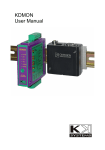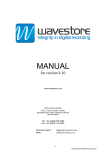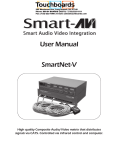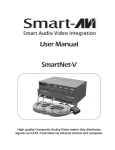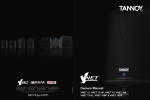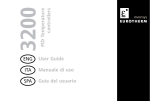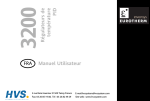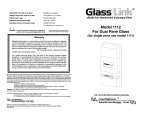Download KD420 User Manual
Transcript
KD420 User Manual Copyright © 2004-2013 KK Systems Ltd. No reproduction of any part of this document, in any form, is allowed without prior written permission from KKSystems Ltd. All other copyrights and trademarks acknowledged. Extract from Conditions of Sale Any electronic device or system can fail, possibly resulting in the loss of valuable programs or data. It is your responsibility to ensure that all such valuable material is backed-up at all times. We are not liable for any direct, indirect or consequential loss caused directly or indirectly through the use of this product. All our software is sold on an “as is” basis without a warranty of any kind. We do not claim that this product is suitable for all potential applications. It is your responsibility to verify that the product works in its intended application. In the interest of progress, we reserve the right to alter prices and specifications without prior notice. Safety Warning The KD420 is not authorised for use in any situation where injury or death could result from its failure. No interface should be connected to a dangerous potential. Contents 1. KD420 Overview ..........................................................................1 1.1 Quick Start Guide ............................................................................................3 1.2 Block Diagram..................................................................................................4 1.3 Front Panel Description ..................................................................................5 1.4 Options Switch.................................................................................................5 1.5 1.5.1 1.5.2 1.5.3 1.6 KD420 Analogue Input Circuitry.....................................................................6 Voltage Input ...............................................................................................6 Current Input ...............................................................................................7 KD420 Analog Measurement Accuracy ......................................................7 Power Requirements .......................................................................................8 2. Specification ................................................................................9 3. Ports and Connections Reference...........................................10 3.1 3.1.1 Port 1 - KD420 Configuration........................................................................10 Port 1 – KD420 Modbus Slave 2-Wire and 4-Wire....................................12 3.2 Port 2 – Analog Sensing ...............................................................................14 3.3 Port 2 – 2-wire RS485 Modbus Master.........................................................15 4. Mounting.....................................................................................17 5. Configuration .............................................................................18 6. 5.1 Installing KD420 Configuration Software ....................................................18 5.2 Using KD420 Configuration Software..........................................................18 5.2.1 Modbus Slave Settings .............................................................................20 5.2.2 ADC Settings.............................................................................................22 5.2.2.1 Noise Reduction...............................................................................22 5.2.2.2 Performance Options .......................................................................23 5.2.3 Modbus Master Settings ...........................................................................25 5.2.3.1 Modbus Register Numbering ...........................................................26 5.2.4 Monitor Page.............................................................................................26 Troubleshooting ........................................................................27 6.1.1 6.1.2 7. KD420 Power Up Problems ......................................................................27 KD420CFG.EXE unable to connect ..........................................................27 KD420 Configuration via Modbus............................................28 7.1 7.1.1 7.1.2 7.1.3 Configuration Registers................................................................................28 Modbus Register Numbering ....................................................................28 Communications Parameters....................................................................29 Voltage and current format........................................................................30 KD420 User Guide 1. KD420 Overview The KD420 is an analog sensor to Modbus interface which supports the following analog inputs • • • analog current 4-20mA (a 20V sensor supply is provided) analog voltage –30V to +30V external relay contact sensing (uses the analog voltage input) It presents the values in the following ways which are all updated concurrently: 1) They are readable via Modbus RTU SLAVE registers In this case, the following data formats are presented concurrently: • • • • • • • • • • • 40000: Current in 4-20mA range (logical value: 1=yes, 0=no) 40001: Current – as a 16-bit unsigned integer in microamps (0 to 64000) 40002: Current – as a 32-bit IEEE float. point value, big-endian, mA (2 registers) 40004: Current – as above, little-endian (2 registers) 40006: Current – as a null-terminated textual float +00.000, mA (8 registers) 40020: Current – as above, E notation +0.000e+00 (11 registers) 40101: Voltage – as a 16-bit signed integer in millivolts (-32000 to +32000) 40102: Voltage – as a 32-bit IEEE float. point value, big-endian, V (2 registers) 40104: Voltage – as above, little-endian (2 registers) 40106: Voltage – as a null-terminated textual float +00.000, V (8 registers) 40120: Voltage – as above, E notation +0.000e+00 (11 registers) 2) The KD420 writes them into an RS485 Modbus RTU SLAVE device A Modbus register in the KD420 is used to configure the following parameters • • • Starting register number to write to Selection of which parameter and data format to write Update interval (1-60 seconds) Version 1.0 Page 1 Version 1.0 POWER SUPPLY 7-35V DC 300mA RS422 or 2- wire RS485 or 4- wire RS485 MODBUS MASTER Modbus RTU Slave Interface Modbus RTU Master Interface Analog Interface 2- wire RS485 4-20mA TC Modbus RTU SLAVE device _ + Thermocouple Transmitter with a 4-20mA Interface KD420 User Guide Page 2 KD420 User Guide 1.1 Quick Start Guide • Unpack the unit and check you have the following items: KD420 User Manual • The factory configuration of both KD420 serial ports is: 9600 baud 8 bits/word No parity 1 stop bit If this is not as desired, the KD420 can be reconfigured for a wide range of baud rates from 30 to 115200. This requires KD420’s Port 1 to be connected to a Windows computer, via an RS422 interface. The supplied KD420CFG.EXE program is used. Port 1 is available on both the 8-way connector and on the RJ11 connector. For configuration instructions, see page 18. For a Windows computer with RS232 or USB ports, a suitable RS422 interface is the KK Systems K2, K2-TB, USB-485, KD485-STD. If you wish to configure the KD420 via Modbus (i.e. without using the KD420CFG.EXE program), see page 28. • Refer to the configuration section on page 18 and configure the KD420 as required. Version 1.0 Page 3 KD420 User Guide 1.2 Block Diagram Options Switch 1 2 3 4 Data Flow Indicator LEDs RJ-11 DEBUG PORT 1 GND 4-20 OK 2RX 1TX 1RX RS485 driver control TXA PORT 1 1 RS-4XX 2 3 4 CFG 20V TXB RXA INPUT 2 RXB DO NOT CONNECT 6 PORT 1 GND INPUT 1 5 47R A-D CONVERTER 5 6 0 to -1V PROCESSOR & MEMORY 4 GND -33V to +33V 3 B 2 A 1 RS-485 ISOLATION PORT 2 +5V 22k RS-485 driver control 22k POWER + 7 INPUT _ 8 10k GND SWITCHING POWER SUPPLY Port 1 is RS422/485 and is used for the KD420’s Modbus Slave interface. It also serves as a configuration port; all KD420 features are configured using the supplied KD420CFG.EXE Windows program. Port 1 is accessible via the 8-way “Port 1” terminal block and via the RJ-11 connector. Only one of these two connectors may have connections to it at any one time. The RJ-11 is provided for specialised applications. Port 2 is a composite connection for the two analog (voltage and 4-20mA current) features, and for the 2-wire RS485 interface which can operate as a Modbus Master. Pin 4 of Port 2 should always be connected to earth or a good ground. This is because Port 2 is fully floating and the grounding helps to eliminate static charge and optimise EMC compatibility. Version 1.0 Page 4 KD420 User Guide 1.3 Front Panel Description KD420 Switch used to enter C onfiguration Mode 4-20 OK 4-20mA current wit hin limits * 2RX Port 2 receiving data 1TX Port 1 transmitting data 1RX Port 1 receiving data CFG Config uration Mode active POWER Power ON SENSOR INTERFACE * this LED has other functio ns also SYSTEMS The front panel functions are mostly self-explanatory. The 4-20 OK LED illuminates when the current drawn by the 4-20mA analog sensor is inside those limits. This LED also indicates A-D converter activity; this takes place approximately every second. Only the general (continuous) state of this LED indicates whether the 4-20mA current is within its limits. 1.4 Options Switch Options Switch ON 1 2 3 4 This switch is currently unused. Version 1.0 Page 5 KD420 User Guide 1.5 KD420 Analogue Input Circuitry The KD420 has two analogue inputs: voltage and current. An understanding of the internal implementation of these is not usually necessary but may be useful in some applications. 1.5.1 Voltage Input There are three particular aspects to be aware of: The A-D converter has a resolution of 12 bits i.e. 1 part in 4096 or 0.025%. The measurable voltage input range is -33V to +33V. If the voltage range you are measuring fully spans this range, you will get the full 0.025% resolution. If however you are measuring a much smaller voltage range e.g. just 0 to +1V then the resolution will drop correspondingly to 1.6%. The absolute accuracy of the measurement will be similarly affected. The input resistance of the voltage input is not infinite; it is about 140k ohms. This means that if the source resistance of your voltage source is e.g. 1.4k ohms, you will get a 1% measurement error. When the voltage input has nothing connected to it, it floats up to +1.25V. This incidentally enables the sensing of e.g. an isolated relay contact connected between the voltage input and its analogue ground, by connecting the relay contact across the KD420 voltage input. Version 1.0 Page 6 KD420 User Guide 1.5.2 Current Input This is designed for standard 4-20mA transducer transmitters. The current is passed through a 47 ohm resistor and the voltage drop across this resistor is measured, using the 12-bit A-D converter. The measurable current range is 0 to 22mA and the 12-bit A-D conversion gives a resolution of 0.025% i.e. 6uA. The KD420 provides an unregulated -20V output (which approximately tracks the KD420 supply voltage, minus 4 volts) for powering the 4-20mA transducer. To use this supply, connect it to the negative terminal of the transducer, and connect the positive terminal of the transducer to the KD420 current measurement input. Consult the wiring diagrams for details. 1.5.3 KD420 Analog Measurement Accuracy We specify the voltage/current measurement accuracy at 1% of full scale, over the specified temperature range. The actual factory calibration procedure is done at room temperature to around 0.05%. Version 1.0 Page 7 KD420 User Guide 1.6 Power Requirements The power supply specification depends on the mode of operation. The KD420 power input is 11-35V DC, 2 watts max. The constant power nature of the internal power circuitry means that at a higher supply voltage it will draw less current. The following diagram shows the relationship 260 240 220 Input Current (mA) 200 180 The peak current which occurs around 4V can reach 600mA. 160 140 120 Input must reach the startup voltage (typ. 4V, guaranteed 7V) in less than 1 second otherwise the power supply will not start up. 100 80 60 40 20 0 0 2 4 6 8 10 12 14 16 18 20 22 24 26 28 30 32 34 36 Input Voltage (V) This means that a power unit needs to be rated at 300mA, to handle the startup current, even though the KD420 will draw much less at say 24V. However, the 20V output (provided for powering a 4-20mA analog sensor) is not regulated and approximately tracks the KD420 supply voltage, minus 4V. This output is intended to work with a 24V power input to the KD420. Version 1.0 Page 8 KD420 User Guide 2. Specification RS422/485 interface: Receiver threshold 200mV typ (differential). Hysteresis 70mV typ. Voltage monitoring: -30V to +30V. Input impedance 100kΩ min Source impedance 100Ω max (for best accuracy) Measurement accuracy 1% Absolute maximum input -60V to +60V Current monitoring: 4mA to 20mA. Sensing resistance 47Ω. Measurement accuracy 1% Absolute maximum current 50mA 20V output: Within 17V to 23V with a 24V DC KD420 power input. Current limited at 30mA typ; short circuit protected (1 minute) Isolation: 3-way isolated (Port 1 - Port 2 - Power In) 64V PK, tested at > 1000V AC RMS, 1 second. All Port 2 features share a common ground (pin 4). Environmental: Operating temperature -20C to +50C. Storage temperature -25C to +70C. Relative humidity 0 to 90%, non-condensing. Ventilation: Rail-mounted KD420 must have a 50mm gap above and below. EMC compliance: Emissions EN50081-2 (94). Immunity EN50082-2 (95) Dimensions: 29mm (W) x 114mm (H) x 97mm (L) approx in rail-mounted position, incl. screw terminals. Version 1.0 Page 9 KD420 User Guide 3. Ports and Connections Reference Port 1 has two functions: KD420 configuration, and the Modbus RTU Slave connection. It is accessible via the 8-way “Port 1” terminal block or via the RJ-11 connector. Only one of these two connectors may have connections to it at any one time. The RJ-11 is provided for specialised applications where a custom cable is used. Port 2 is used for the analog sensors and for a Modbus RTU Master mode. 3.1 Port 1 - KD420 Configuration When used for KD420 configuration, Port 1 operates in RS422 mode i.e. 4 wires plus ground. The configuration program, KD420CFG.EXE, runs under Windows. There are two common methods for creating an RS422 interface on a Windows computer: an RS232 to RS422 converter, or a USB-RS422 converter. The following instructions show the connections: KD420 Configuration Connections using a RS232 to RS422 Converter IBM-compa tible PC with a 9-wa y ser ial port Port 1 screw termi nal s RS232 RXA (2) [3] RXB (7) [4] TXA (8) [1] TXB (3) [2] GND (5) [5] RJ-11 connector (vi ew from outsi de) KD420 internal connections TXA 1 TXB 2 RXA 3 RXB 4 K2 or K2-TB RS232 to RS422 Converter Pin numbers shown for both (K2) and [K2-TB] 5 GND 6 7 IMPORTAN T: The screw termin als and the RJ11 are internally interconn ected . The y are no t separate se rial ports. U se o nly one at an y time. 8 Version 1.0 Page 10 KD420 User Guide KD420 Configuration Connections using the KK Systems USB-485 Converter IBM-compa tible PC with a USB port Port 1 screw termi nal s USB-485 Converter USB RXA (2) RXB (7) TXA (8) TXB (3) GND (5) RJ-11 connector (view from outsi de) KD420 internal connections TXA 1 TXB 2 RXA 3 RXB 4 5 GND 6 7 IMPORTANT: The screw terminals and the RJ11 are internally intercon nected . Th ey a re n ot separate se rial ports. U se only one a t a ny time. 8 Note: normal KD420 configuration will also work over 2-wire RS485 because it is done by writing to Modbus registers. However, the firmware upgrade option needs RS422 (4-wire), which is also sometimes called “4-wire RS485”. Port 1 can be built with an RS232 interface as a custom option – contact factory. Version 1.0 Page 11 KD420 User Guide 3.1.1 Port 1 – KD420 Modbus Slave 2-Wire and 4-Wire The following diagrams show both 4-wire and 2-wire RS485 connections for Port 1: Version 1.0 Page 12 KD420 User Guide RS485 Bus Termination On cable runs exceeding around 300 metres, two terminators should be connected in the usual locations, at both ends of the cable(s). An example of these is shown in the Port 2 notes on page 15. Each terminator should be a resistor equal in value to the characteristic impedance of the cable which for good quality data communication twisted pair cables is around 110 ohms. For best results a 10nF capacitor should be in series with each resistor; this eliminates the DC loading of the termination resistor. Version 1.0 Page 13 KD420 User Guide 3.2 Port 2 – Analog Sensing The following diagram shows the two KD420 analog functions: 4-20mA and voltage measurement. The KD420 can operate both concurrently. KD420 RJ-11 Thermocouple Transmitter with a 4-20mA Interface 4-20mA Port PORT 1 + PORT 2 1 6 2 5 3 4 4 3 5 2 6 1 _ TC 4-20mA _ Voltage Measurement Input _ 30V to + 30V + Pin 4 of the Port 2 terminal block should be earthed for best electrostatic and EMC performance 7 8 EARTH For powering the 4-20mA transducer, the KD420 provides an unregulated -20V output (which approximately tracks the KD420 supply voltage, minus 4 volts) on pin 6. Refer to the overall diagram on page 4. This supply is connected to the negative terminal of the transducer as shown in the above diagram, and the positive terminal of the transducer is connected to the KD420 current measurement input (pin 5). Important: KD420 isolation is between Port 1, Port 2, and the power input. The various features on Port 2 (4-20mA, voltage input, and 2-wire RS485) are NOT isolated from each other and they share a common ground (pin 4). Version 1.0 Page 14 KD420 User Guide 3.3 Port 2 – 2-wire RS485 Modbus Master KD420 can act as a Modbus RTU Master and can write the process values seen on the 420mA and/or +/-30V inputs into specified registers of a single Modbus RTU Slave. RJ-11 KD420 PORT 1 PORT 2 1 6 2 5 3 4 4 3 5 2 6 1 MODBUS RTU SLAVE device GND B T A T 7 8 Pin 4 of the Port 2 terminal block should be earthed for best electrostatic and EMC performance EARTH Note that Modbus communication in this mode (Port 2) has priority over Modbus communication on Port 1. Normally this will never be seen, but if the Slave device attached to Port 2 is very slow to respond, this could cause long response times on Port 1. RS485 Bus Termination On cable runs exceeding around 300 metres, two terminators should be connected as shown. Each terminator should be a resistor equal in value to the characteristic impedance of the cable which for good quality data communication twisted pair cables is around 110 ohms. For best results a 10nF capacitor should be in series with each resistor; this eliminates the DC loading of the termination resistor. Version 1.0 Page 15 KD420 User Guide Important: KD420 isolation is between Port 1, Port 2, and the power input. The various features on Port 2 (4-20mA, voltage input, and 2-wire RS485) are NOT isolated from each other and they share a common ground (pin 4). Version 1.0 Page 16 KD420 User Guide 4. Mounting The KD420 clips to a standard 35mm DIN rail 114mm 35mm symmetric DIN rail Overall Dimensions (including terminals) 29mm 97mm Removing unit from DIN rail Method 1 Lift base of unit upwards Method 2 Use a suitable tool to open up DIN rail clip Version 1.0 Page 17 KD420 User Guide 5. Configuration The KD420 is configured by connecting a PC serial port, via an RS232 or USB to RS422 converter, to the KD420 (port 1) and running the supplied KD420CFG.EXE configuration program. This software provides a graphical interface for configuring the KD420. To connect to the KD420, refer to KD420 Configuration on pages 18-22. Suitable RS232-RS422 or USB-RS422 converters are available from KK Systems Ltd. 5.1 Installing KD420 Configuration Software To install KD420CFG.EXE, click on the KD420CFG.MSI file and follow the instructions. 5.2 Using KD420 Configuration Software In order for KD420CFG.EXE to communicate with the KD420, briefly press the button on the KD420 front panel. This puts the KD420 into "config mode" as indicated by the CFG LED being illuminated continuously. When in the config mode, the KD420 Port 1 communication settings are changed to 9600,n,8,1 and Modbus slave address 1. The KD420 will remain in config mode for 1 minute unless it remains connected to a PC running KD420CFG.EXE. After this time, it will automatically revert to the communication settings and port address dictated by the current configuration settings and the CFG LED will go out. Tthe KD420 config mode can be terminated at any time, by pressing the KD420 front panel button, or by powering down the KD420. The KD420 will also enter config mode when it powers up. If KD420CFG.EXE does not communicate with the KD420 within 5 seconds, the KD420 it will exit config mode and start up normally. Version 1.0 Page 18 KD420 User Guide With the KD420 connected to the PC serial port and powered up, start the KD420CFG.EXE Configuration program from the shortcut in the Window “Start” menu. You should see the following: Select the PC port that the KD420 is connected to (or press Demo to explore the program without actually having the KD420 connected). Version 1.0 Page 19 KD420 User Guide 5.2.1 Modbus Slave Settings The following tab configures functions applicable to Port 1 (RS485 Modbus RTU Slave): The “Sample whenever…” option reads one or both of the analog parameters (those that are enabled in the ADC Settings tab) every time there is any Modbus read, and returns those values. This will thus always return the most recent value. The “Sample every…” option is provided for applications where the fastest possible Modbus comms response is required but the analog parameter being measured does not need to be read each time. This option reads one or both of the analog parameters (those that are enabled in the ADC Settings tab) at the specified interval and stores them in memory from which they can be retrieved by a read of the appropriate Modbus registers. When the “Sample every…” option is selected, the A-D conversion, and any 50/60Hz noise filtering selected, are done in the background. The Modbus response time is thus reduced to little more than the serial comms time which depends primarily on the baud rate and the Version 1.0 Page 20 KD420 User Guide length of the parameter being read. See the Performance description on the following pages for details. An obvious example for the “Sample every..” option might be temperature which can usually be adequately read once per second, but if 100 KD420 units are connected to an RS485 bus then the highest Modbus comms performance is required in order to interrogate them all within a reasonable time. Important: The KD420 uses the “Performance” options in the ADC Settings tab to decide which of the two (current and/or voltage) analog values should be read by the A-D converter. It does not attempt to work it out by looking at which Modbus registers are being read. This maximises performance, but if e.g. the “Enable voltage channel” option is disabled, a read of the Voltage registers (40101 onwards) will return garbage. The Slave Address is the Modbus address on which the KD420 will respond when not in configuration mode.. Version 1.0 Page 21 KD420 User Guide 5.2.2 ADC Settings The following tab configures A-D converter options: 5.2.2.1 Noise Reduction When the 50Hz or 60Hz option is set, the KD420 reads the analog value continuously for 20ms or 17ms respectively, adds up the readings, and divides that by the number of readings taken. The number of readings thus averaged is approximately 30 or 26, respectively. This provides a high degree of filtering of noise, especially mains (power line frequency) noise. Setting this value to “none” performs a single read with no averaging. This setting will provide the fastest read times but without any attempt to eliminate mains generated noise on the input. Version 1.0 Page 22 KD420 User Guide 5.2.2.2 Performance Options Normally these 3 options are all enabled and any Modbus read will populate all KD420 registers. These options are provided for applications where Modbus comms performance and the analog reading rate need to be optimised concurrently. When a Modbus Master reads the KD420, the total time will be the sum of these 5 items: 1. Modbus Read command packet to the KD420 – this depends mainly on the baud rate 2. A-D conversion – this takes 0.65ms for each analog channel. If the 50Hz or 60Hz filtering is enabled, add 20ms / 17ms respectively for one analog channel or 40ms / 34ms respectively for two. 3. Formatting the return data – this takes around 500μs for the textual float formats and much less for the other data types 4. Modbus protocol related tasks e.g. enforcing the 3.5 byte “dead time”, CRC checking and generation, etc. 5. Modbus Read return packet from the KD420 – this depends mainly on the baud rate and the type of parameter being read At the commonly used baud rate of 9600, or any lower value, there is little to be gained from changing the KD420 factory defaults because the Modbus comms time (items 1 and 5 above) dominates. At the highest available baud rate of 115200, the comms time is much shorter – particularly if only a 16-bit integer value is being read – and there is a progressive improvement to be gained by using the KD420 features selectively. Let’s look at some actual cases: The fastest comms option is to select the “Sample every…” mode, and then enabling and reading a single analog channel as a 16-bit integer at 115200 baud takes a total of 4.5ms i.e. 220 readings per second. But the actual analog value will be updated only at intervals of 1 second or longer. The 50/60Hz filter setting is available but does not affect the comms performance. The “Enable textual…” option has no effect on the timing in this mode. The 2nd fastest option uses the “Sample whenever…” mode, no 50/60Hz filtering, unchecking the “Enable textual…” option, and then enabling and reading a single analog channel as a 16-bit integer at 115200 baud takes a total of 6.3ms i.e. 150 readings per second. Reading the same data as a 11-byte textual float takes 9.5ms i.e. 105 readings per second. Version 1.0 Page 23 KD420 User Guide The above but at 9600 baud takes 25ms and 45ms respectively. The slowest option (at 9600 baud) is with all factory defaults, 50Hz filtering on, and reading an 11-byte textual float, which will take about 65ms for one channel. Version 1.0 Page 24 KD420 User Guide 5.2.3 Modbus Master Settings The following tab configures the Modbus Master feature that enables the KD420 to write analog values into a Modbus RTU Slave attached to Port 2: The Modbus master can write voltage and current values in any one of a number of formats. Some of these formats will use a number of consecutive 16 bit Modbus holding registers: Format #Registers, 16 bit integer 1 32bit IEEE floating point value (big endian) 2 32bit IEEE floating point value (little endian) 2 ASCII textual float (+00.000 format), null terminated 8 ASCII textual float (+0.000E+00 format), null terminated 11 Boolean: within 4-20mA range (1=yes, 0=no) (current only) 1 Version 1.0 Page 25 KD420 User Guide 16 bit integer values measure current as 0 to 64000 (in mA x 1000) and voltage as -32000 to +32000 (in volts x 1000). 5.2.3.1 Modbus Register Numbering There is often confusion over Modbus register numbering with some manufacturers using the older Modicon 4xxxx notation and others using register numbers based from 1. The Modbus register numbers used with the KD420 should be specified as a decimal number based from zero and with the Modbus function code determining the register type. For example to read Modbus holding register 40001, you would specify register 0 and function code 3 (read holding registers). Similarly, to read Modbus input register 30099, you would specify register 98 and function code 4 (read input registers). 5.2.4 Monitor Page This tab offers a debugging function: Version 1.0 Page 26 KD420 User Guide 6. Troubleshooting 6.1.1 KD420 Power Up Problems With a 24V power input, there should be an output of approximately 20V between pin 4 and pin 6 of the 6-way Port 2 terminal block, with pin 4 being the positive terminal. The KD420 internal power supply will fail to start if the supply voltage rises from zero to the internal power supply startup voltage (approximately 4V) very slowly. See the Power Requirements section for details. If after power-up, the CFG LED enters a repeating pattern of n rapid blinks followed by a longer pause, this indicates that a hardware fault has been detected by the KD420 powerup test firmware. This fault requires a return to the factory. 6.1.2 KD420CFG.EXE unable to connect Check the COM port is correct. If using a USB to RS422 converter, look in Control Panel / Devices / COM&LPT Ports to see what COM port number has been allocated by the operating system. Version 1.0 Page 27 KD420 User Guide 7. KD420 Configuration via Modbus 7.1 Configuration Registers 7.1.1 Modbus Register Numbering There is often confusion over Modbus register numbering with some manufacturers using the older Modicon 4xxxx notation and others using register numbers based from 1. The Modbus register numbers used with the KD420 should be specified as a decimal number based from zero and with the Modbus function code determining the register type. For example to read Modbus holding register 40001, you would specify register 0 and function code 3 (read holding registers). Similarly, to read Modbus input register 30099, you would specify register 98 and function code 4 (read input registers). The KD420 implements the following Modbus holding registers (within the KD420 Port 1 Modbus slave) for the purpose of "in-the-field" reconfiguration of the KD420. Configuration is performed by updating any of these values (in any sequence). The configuration update only actually takes effect once the value ABCDh is written to register number 40200 (register address 199). The configuration registers (starting with register 40201) listed below can be both written to and read from. The current effective configuration values can always be read from a similar sequence of registers starting at register 40301. Register Value 40201 (200) Port 1 (KD420 Slave port) comms settings (see below) 40202 (201) Port 2 (KD420 Master port) comms settings (see below) 40203 (202) Port 1 (KD420 Slave) address (1 to 247) 40204 (203) Port 1 (KD420 Slave) sample interval (0 for on demand, or interval between 1000 to 60000ms) 40205 (204) Port 2 (KD420 Master) slave device address (to write to) (0 to 247) Version 1.0 Page 28 KD420 User Guide 40206 (205) Port 2 (KD420 Master) number of retries (0 to 65535) 40207 (206) Port 2 (KD420 Master) timeout (0 to 65535ms) 40208 (207) Port 2 (KD420 Master) 4-20mA sample interval (0 to disable or 1000 to 60000ms) 40209 (208) Port 2 (KD420 Master) slave starting register for 4-20mA (to write to) 40210 (209) Port 2 (KD420 Master) 4-20mA format (see below) 40211 (210) Master: voltage sample interval (0 to disable or 1000 to 60000ms) 40212 (211) Master: slave starting register for voltage (to write to) 40213 (212) Master: voltage format (see below) 40214 (213) ADC noise averaging (0 for 50Hz, 1 for 60Hz) 7.1.2 Communications Parameters Each communications port configuration is packed into a 16 bit holding register. bit# 15 14 13 12 11 10 9 value 8 7 6 5 4 3 2 1 0 SB P1 P0 BW baud rate Where: SB defines the number of stop bits: 1 = 2 stop bits; 0 = 1 stop bit; P1, P0 define the parity: 0 = off; 1 = even; 2 = odd; The least significant (LS) 8 bits indicate the baud rate with values 0 to 20 corresponding to 30 to 115200 as follows: bits 7-0 Baud Rate 0 30 1 37.5 Version 1.0 Page 29 KD420 User Guide 2 50 3 75 4 100 5 110 6 134.5 7 150 8 300 9 600 10 1200 11 2000 12 2400 13 3600 14 4800 15 7200 16 9600 17 19200 18 38400 19 57600 20 115200 7.1.3 Voltage and current format The following voltage and current (4-20mA) format values are used to determine the format used when the KD420 (acting as a Modbus Master on its Port 2) writes a voltage or current value to the Modbus Slave device. Format #Registers Config Value 16 bit integer 1 0 32bit IEEE floating point value (big endian) 2 1 32bit IEEE floating point value (little endian) 2 2 ASCII textual float (+00.000 format), null terminated 8 3 ASCII textual float (+0.000E+00 format), null terminated 11 4 Version 1.0 Page 30 KD420 User Guide Boolean: within 4-20mA range (1=yes, 0=no) (4-20mA only) 1 5 KK Systems Ltd Tates, London Road Pyecombe, Brighton BN45 7ED Great Britain www.kksystems.com Version 1.0 Page 31



































